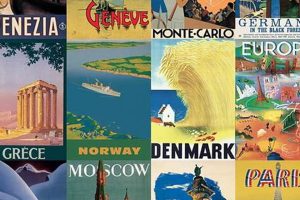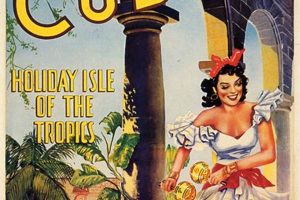These artistic advertisements, created for the former Pan American World Airways, represent a significant genre of graphic design. The pieces typically feature vibrant imagery, promoting travel to exotic locales and embodying the optimism of the jet age. Examples often depict idyllic scenes of popular tourist destinations, illustrated in a variety of artistic styles ranging from mid-century modern to stylized realism.
Their value extends beyond mere commercial art. They serve as historical artifacts, offering insights into the cultural values, travel trends, and aesthetic preferences of a bygone era. These visuals evoke a sense of nostalgia and showcase the evolution of marketing strategies. Furthermore, they document the expansion of global tourism and the increasing accessibility of international travel during the airline’s operational period.
The following sections will delve deeper into the artistic characteristics, historical significance, collectibility, and impact of these visually compelling travel promotions.
Acquiring and Preserving Aviation-Themed Art
This section provides essential guidance for individuals interested in collecting and maintaining vintage travel advertisements produced for Pan American World Airways.
Tip 1: Authenticate the Piece: Prioritize confirming the originality of any potential acquisition. Examine the paper stock, printing techniques, and any markings for consistency with known characteristics of originals from the period.
Tip 2: Assess Condition Carefully: Thoroughly evaluate the physical state of the item. Look for signs of damage such as fading, tears, water stains, or repairs. Lower condition significantly impacts value.
Tip 3: Research Market Value: Investigate comparable sales to understand prevailing prices. Auction records, dealer inventories, and online marketplaces can provide useful data points for gauging fair market value.
Tip 4: Consider Framing and Storage: Employ archival-quality framing materials, including acid-free mats and UV-protective glazing, to safeguard against light damage and deterioration. Store unframed items flat in acid-free enclosures in a cool, dry environment.
Tip 5: Document Provenance: Maintain a record of the object’s history, including previous owners, purchase dates, and any relevant documentation. Established provenance enhances value and authenticity.
Tip 6: Consult with Experts: Seek advice from experienced dealers, conservators, or appraisers specializing in vintage paper ephemera. Their expertise can prove invaluable in making informed decisions regarding acquisition and preservation.
Tip 7: Insure the Collection: Obtain appropriate insurance coverage to protect against loss, theft, or damage. Consult with an insurance professional to determine the appropriate level of coverage based on appraised value.
Adhering to these guidelines will assist in acquiring and preserving these historical artifacts, ensuring their longevity for future generations.
The subsequent section will provide a concluding summary of the key points discussed throughout this article.
1. Iconic Designs
The intersection of graphic design and aviation history is epitomized by the advertisements of Pan American World Airways. These visuals, beyond their function as promotional material, evolved into exemplars of mid-century design principles. The distinctive aesthetic of these materials is a critical component of their enduring appeal and historical significance. This prominence arises from the deliberate use of bold typography, vibrant color palettes, and evocative imagery, all of which contributed to the creation of a recognizable brand identity.
Real-world examples abound. The signature globe logo, frequently incorporated into the composition of various posters, is an instance of recognizable branding. The depiction of destinations like Hawaii, Paris, or Rio de Janeiro through stylized illustrations established a visual vocabulary associated with luxury travel and exotic locales. The influence of design movements such as Art Deco and Swiss Style are discernible, reflecting the aesthetic currents of the period. As a consequence, understanding the design elements is essential to fully appreciate these examples as cultural and historical artifacts.
In summation, the designs associated with Pan American World Airways have transcended their original purpose. Their visual appeal, strategic branding, and reflection of prevalent artistic trends have cemented their status as icons. By analyzing these elements, individuals gain a deeper understanding of the airline’s role in shaping the perception of international travel and the evolution of graphic communication.
2. Travel Promotion
The objective of Pan American World Airways advertisements was fundamentally travel promotion. These visuals were meticulously crafted to stimulate demand for air travel to a variety of destinations. The posters functioned as strategic marketing tools, designed to cultivate desire and shape perceptions. The imagery employed played a crucial role in constructing an image of luxury, safety, and accessibility associated with the airline and the destinations it served.
Real-world examples illustrate this connection. Posters depicting idyllic beaches in the Caribbean, or sophisticated urban scenes in European capitals, served as visual invitations to experience these locales firsthand. The advertisements emphasized speed, convenience, and comfort, mitigating perceived barriers to international travel. The posters directly affected consumer behavior by influencing travel decisions and fostering a sense of aspiration. Therefore, the posters were vital as effective marketing tools in the aviation industry.
In conclusion, the success of the vintage Pan Am advertising lay in the travel promotion. The posters exemplify effective marketing strategies, showcasing destinations and simplifying complexities. A comprehension of this relationship sheds light on the airline’s role in democratizing travel during the jet age and influencing tourism trends.
3. Historical Context
The vintage advertisements created for Pan American World Airways are intrinsically linked to the socio-economic and technological conditions of their time. An understanding of this era is crucial for interpreting the cultural significance and artistic merit of these promotional materials.
- The Jet Age and the Democratization of Travel
The introduction of jet aircraft dramatically reduced travel times and costs, making international destinations more accessible to a broader segment of the population. These visuals reflect this newfound accessibility, portraying travel as a glamorous and attainable experience rather than an exclusive privilege. These artifacts document the shift from luxury ocean liners to mass air transport as the primary mode of international travel.
- Post-War Optimism and American Hegemony
The period following World War II was characterized by economic expansion and a surge of optimism, particularly in the United States. Pan American World Airways, as a prominent American company, projected an image of global reach and technological prowess. The art became visual representations of American soft power, promoting American culture and values abroad through travel and tourism.
- Evolution of Advertising and Design
The mid-20th century saw significant developments in advertising techniques and graphic design. The advertisements for Pan American World Airways demonstrate the evolution of marketing strategies, from text-heavy announcements to visually driven campaigns emphasizing lifestyle and aspiration. These visuals provide insight into the design trends of the period, including the influence of modernism, Art Deco, and other contemporary movements.
- Cultural Exchange and Globalization
As international travel became more prevalent, it facilitated greater cultural exchange and contributed to the increasing interconnectedness of the world. These visuals exemplify the promotion of destinations as exotic and desirable, often romanticizing foreign cultures. This promoted cross-cultural understanding and further solidified Pan Am’s role in global travel and tourism.
In summary, the advertisements created for Pan American World Airways are far more than mere marketing materials; they are historical documents that reflect the complex interplay of technology, economics, culture, and design during a transformative era. Examining these visuals within their historical context provides valuable insights into the evolution of travel, the spread of American influence, and the changing dynamics of global culture.
4. Artistic Style
The aesthetic appeal and enduring legacy of vintage Pan American World Airways advertisements are inextricably linked to the diverse artistic styles employed in their creation. These visuals showcase a range of techniques and influences that reflect the evolving trends in graphic design during the mid-20th century, contributing significantly to their value as cultural artifacts.
- Influence of Mid-Century Modernism
Many visuals exhibit characteristics of Mid-Century Modernism, including clean lines, geometric shapes, and the use of sans-serif fonts. These features impart a sense of efficiency and optimism, aligning with the era’s focus on technological advancement and forward-thinking design. For example, posters promoting destinations such as New York or London often featured streamlined cityscapes and stylized aircraft, reflecting the modernist aesthetic.
- Incorporation of Art Deco Elements
While the Art Deco movement predates the peak of Pan American World Airways’ advertising, its influence is evident in certain pieces, particularly those created in the earlier years of the airline’s expansion. These visuals often showcase symmetry, bold colors, and stylized human figures, evoking a sense of luxury and sophistication reminiscent of the 1920s and 1930s. Destinations such as Miami or Havana are often represented through this lens.
- Stylized Realism and Illustration
A significant number of these advertisements utilize stylized realism, presenting destinations in a picturesque and idealized manner. Skilled illustrators created scenes that captured the essence of a location while enhancing its visual appeal. The application of vibrant colors, meticulous detail, and carefully crafted compositions transformed ordinary landscapes into inviting and aspirational experiences. Posters of destinations like Hawaii or the South Pacific are prime examples of this technique.
- Use of Color Palettes and Typography
The selection and application of color palettes played a crucial role in conveying the desired mood and message. Bold, saturated colors were often used to evoke excitement and adventure, while softer, more muted tones suggested tranquility and relaxation. The typography, ranging from elegant serifs to clean sans-serifs, was carefully chosen to complement the imagery and communicate information effectively. The combination of these elements created a cohesive visual identity that reinforced the Pan American World Airways brand.
In conclusion, the artistic styles seen in vintage Pan American World Airways ads are fundamental to their cultural and aesthetic value. The diverse artistic influences and techniques employed by the artists, designers, and agencies involved, cemented their status as iconic works of graphic communication. These styles highlight how the art contributed to shaping perceptions of international travel during the jet age.
5. Collectibility
The inherent characteristics and historical significance of vintage Pan American World Airways advertising have propelled these artifacts into the realm of collectibility. Factors contributing to this status are multifaceted, extending beyond mere nostalgia to encompass elements of artistic merit, historical importance, and scarcity.
- Rarity and Condition
The limited number of surviving specimens, coupled with variations in condition, significantly impacts value. Pristine, unfolded copies of desirable designs command premium prices. Scarcity is further influenced by print runs, geographical distribution, and the passage of time. These posters become increasingly valued due to its physical condition, and the limited number of copies that exist in the present era.
- Iconic Imagery and Design
Advertisements featuring iconic imagery, such as the globe logo or depictions of famous landmarks, are highly sought after by collectors. The visual appeal of these posters, reflecting the design sensibilities of the mid-20th century, contributes to their desirability. Collectors want to own advertisements that exemplify the airlines signature look and convey the glamour of travel.
- Historical Significance and Nostalgia
The posters provide a tangible link to a pivotal period in aviation history and represent the optimism and glamour associated with the jet age. Nostalgia for this era fuels demand among collectors seeking to preserve a piece of the past. The collectibility represents a tangible link to the history that is coveted by fans of vintage posters, aviation history, and more.
- Provenance and Authentication
The documented history of a particular piece, including previous ownership and exhibition records, can enhance its value and desirability. Authentication by reputable experts is crucial to ensure originality and avoid acquiring reproductions or fakes. Collectors always seek authenticity and historical accuracy in the pieces that they acquire and this demand is very present in the vintage poster market.
These factors intertwine to create a dynamic market for Pan American World Airways advertising. Understanding the nuances of rarity, design, historical context, and provenance is essential for collectors seeking to acquire and preserve these valuable pieces of aviation history.
Frequently Asked Questions about Vintage Pan Am Posters
This section addresses common inquiries regarding the identification, valuation, preservation, and historical significance of these advertising artifacts.
Question 1: How can the authenticity of a Pan Am advertising poster be verified?
Authenticity verification involves examining the paper stock, printing techniques, and presence of any printer’s marks or endorsements consistent with the era. Consultation with a recognized expert in vintage posters is recommended for conclusive determination.
Question 2: What factors influence the valuation of these posters?
Valuation is contingent upon several factors, including condition, rarity, the prominence of the depicted destination or aircraft, and the overall aesthetic appeal. Auction records and dealer inventories provide benchmarks for determining fair market value.
Question 3: What are the optimal methods for preserving these vintage advertisements?
Preservation mandates archival-quality framing with UV-protective glazing and acid-free materials. Storage should be in a climate-controlled environment, away from direct sunlight and humidity. Unframed posters must be stored flat in acid-free enclosures.
Question 4: Are reproductions of these posters common, and how can they be identified?
Reproductions are prevalent. They can often be identified by inferior paper quality, less precise printing, and the absence of original printer’s marks. Careful comparison with known originals is essential.
Question 5: What historical insights do these posters provide?
These visuals offer insights into the evolution of air travel, marketing strategies, and societal attitudes towards international tourism during the mid-20th century. They serve as valuable primary sources for understanding cultural and economic trends of the period.
Question 6: Where can these posters be acquired?
Acquisition avenues include specialized vintage poster dealers, auctions, and online marketplaces. Due diligence is paramount to ensure authenticity and fair pricing. Conducting thorough research and seeking expert advice is strongly encouraged.
Understanding these key aspects aids in appreciating the multifaceted value of these historical artifacts.
The following section will provide a concluding summary of the key points discussed throughout this article.
Conclusion
Vintage Pan Am posters represent a confluence of art, history, and commerce, offering a compelling glimpse into a bygone era of aviation and design. This exploration has highlighted their significance as historical artifacts, artistic expressions, and valuable collectibles. From their iconic designs to their role in promoting global travel, these visuals encapsulate the optimism and ambition of the jet age.
The enduring appeal of these vintage advertisements serves as a reminder of the power of visual communication and the enduring fascination with exploration and travel. Their preservation and study ensure that future generations can appreciate the artistry and historical context embedded within these remarkable pieces of graphic design.







